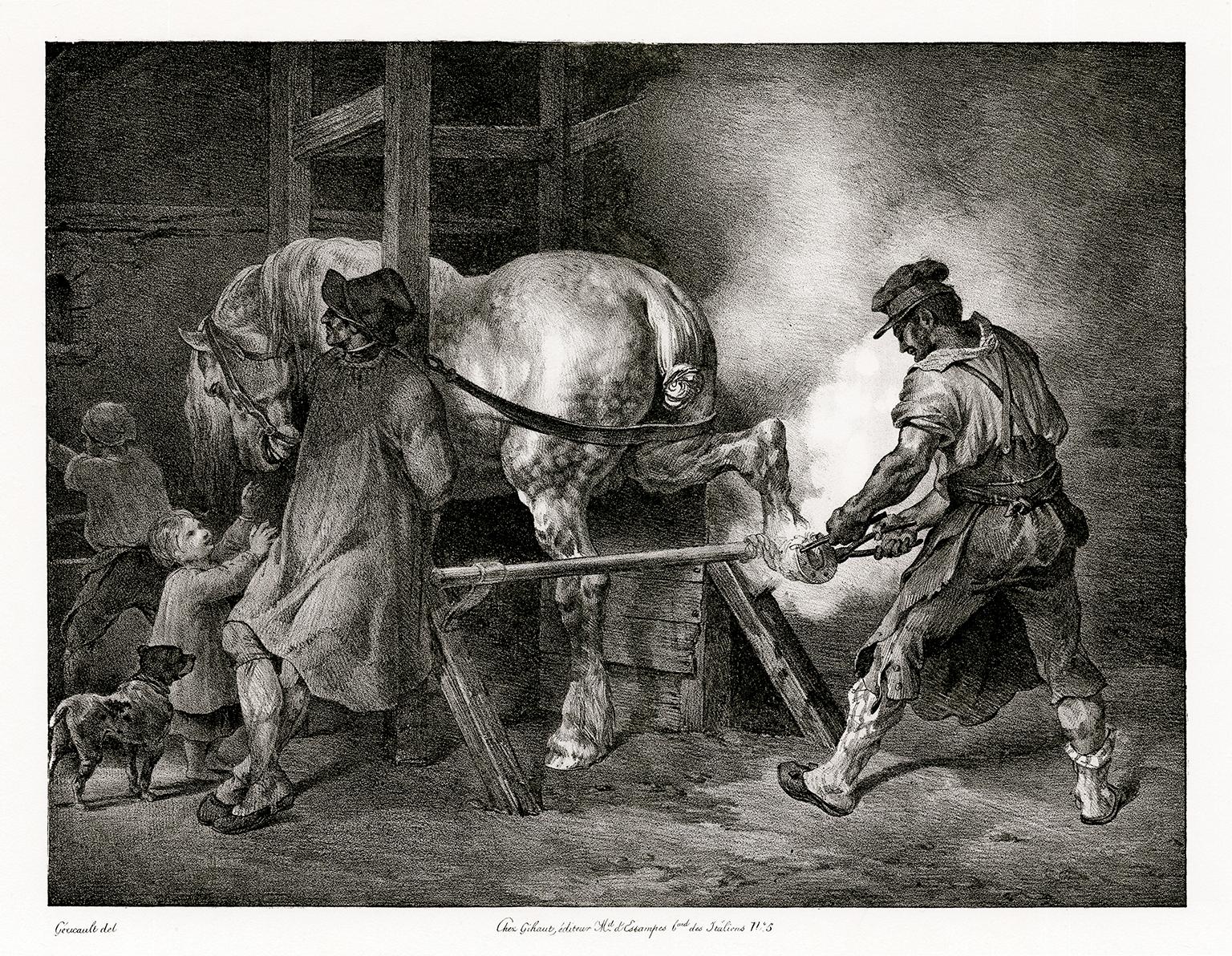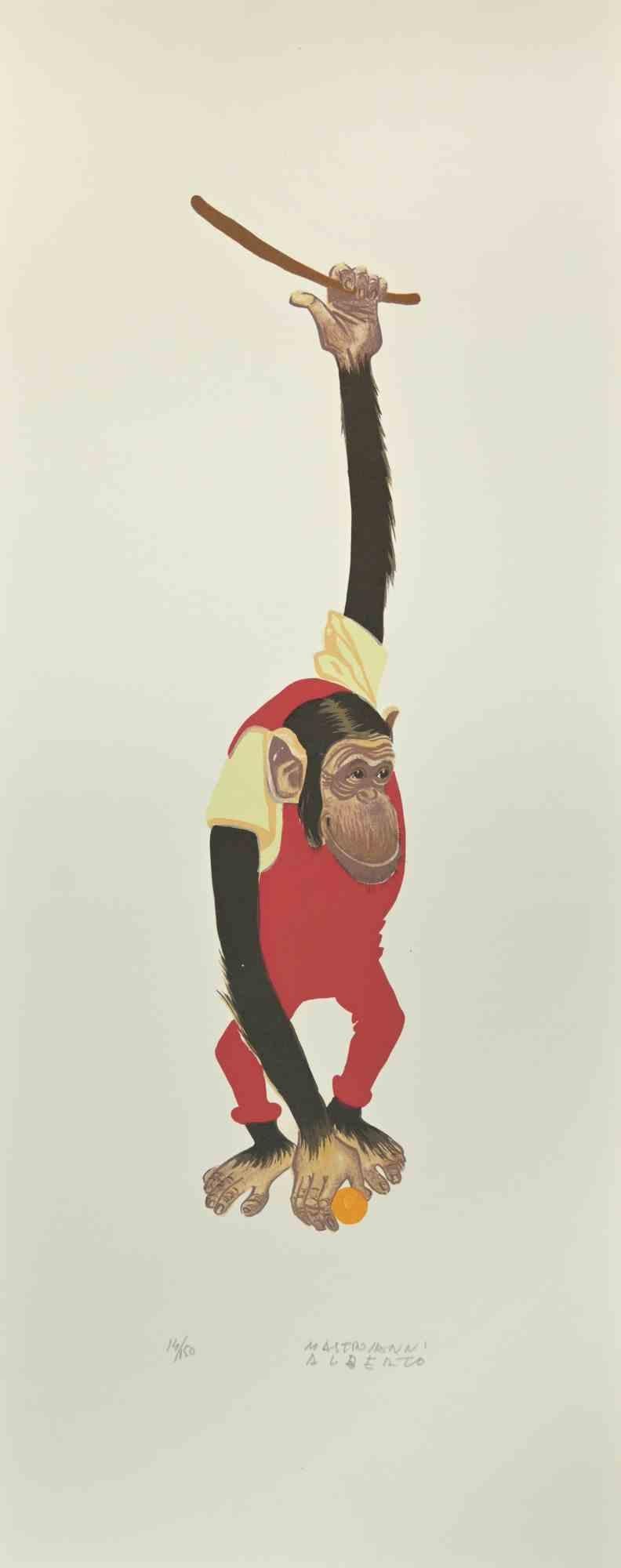Items Similar to 'Horse Attacked by Tiger' — 19th-Century French Romanticism
Want more images or videos?
Request additional images or videos from the seller
1 of 3
'Horse Attacked by Tiger' — 19th-Century French Romanticismc. 1820
c. 1820
About the Item
Théodore Géricault (after), 'Tigre dévorant un cheval' (Tiger Devouring a Horse), lithograph, 3rd state of 3, Clement 97, c. 1820. Lettered 'Volmar d'après Géricault', lower left—this work rendered by Joseph Simon Volmar after a drawing by Gericault. A fine, richly-inked impression, on off-white wove paper, with wide margins (2 1/4 to 3 1/2 inches), in very good condition. Image size 6 1/4 x 8 11/16 inches (159 x 221 mm); sheet size 11 3/8 x 15 3/4 inches (289 x 400 mm). Matted to museum standards, unframed.
ABOUT THE ARTIST
Géricault's fiery, audacious personality and short life fit the mold of Romantic artists of his era and, along with his controversial paintings, profoundly influenced nineteenth-century art. Notwithstanding about three years of studio training, Géricault was largely self-taught. He copied paintings in the Louvre and traveled to Rome, where he discovered Michelangelo's works and the exuberance of Baroque art.
In his enormous 'Raft of the Medusa,' now at the Louvre, Géricault fused Realism and Romanticism, elevating a current event—a shipwreck with few survivors—to the status of monumental art. To achieve authenticity, he used a model of the raft and carefully studied real cadavers—even his friend, Eugène Delacroix, posed for one of the figures. The wreck was attributed to governmental negligence and corruption and the resulting controversy, combined with the painting's veracity, brought Géricault widespread attention.
Géricault was also a master of lithography, the sole printmaking medium he employed to produce his breathtaking representations of horses and military subjects, two of his lifelong passions. During his English sojourn of 1820-21, Géricault improved his knowledge of the lithographic technique in the London workshop of Charles Joseph Hullmandel. The most striking result of this experience was the series of twelve lithographs ‘Various Subjects Drawn from Life and on Stone’, also known as ‘The English Set.’ Géricault continued his studies of the horse once he was back in France, producing the renowned series ‘Etudes, de chevaux lithographiés’.
Géricault died in 1824 at age thirty-two after a prolonged illness caused by a riding accident. His last major works, discovered almost fifty years after his death, were penetrating portraits of the insane. Like the 'Raft of the Medusa,' they offered a new concept of appropriate subject matter for serious painting.
- Creation Year:c. 1820
- Dimensions:Height: 6.25 in (15.88 cm)Width: 8.07 in (20.5 cm)
- Medium:
- Movement & Style:
- After:Jean Louis Andre Theodore Gericault (1791 - 1824, French)
- Period:
- Condition:
- Gallery Location:Myrtle Beach, SC
- Reference Number:
About the Seller
5.0
Recognized Seller
These prestigious sellers are industry leaders and represent the highest echelon for item quality and design.
Platinum Seller
These expertly vetted sellers are 1stDibs' most experienced sellers and are rated highest by our customers.
Established in 1995
1stDibs seller since 2016
256 sales on 1stDibs
Typical response time: 1 hour
Associations
International Fine Print Dealers Association
- ShippingRetrieving quote...Ships From: Myrtle Beach, SC
- Return PolicyA return for this item may be initiated within 7 days of delivery.
More From This SellerView All
- 'Mazeppa' — 19th-Century French RomanticismBy Jean Louis Andre Theodore GericaultLocated in Myrtle Beach, SCThéodore Géricault and Eugène Lami, 'Mazeppa' from the series 'Oeuvres de Lord Byron', lithograph, 1823, 2nd state of 3, Delteil 94. Rendered by Thé...Category
1820s Romantic Animal Prints
MaterialsLithograph
- Le maréchal flamand (The Flemish Blacksmith) — 19th Century French RomanticismBy Jean Louis Andre Theodore GericaultLocated in Myrtle Beach, SCThéodore Géricault 'Le maréchal flamand' (The Flemish Blacksmith) from the series ‘Etudes, de chevaux lithographiés,’ lithograph, 1822, 2nd state ...Category
1820s Romantic Animal Prints
MaterialsLithograph
- 'Foul Rope (Left)' — early American rodeoBy William Robinson LeighLocated in Myrtle Beach, SCWilliam Robinson Leigh, 'Foul Rope (Left)', etching, c. 1920, edition unknown but small. Signed in pencil. Signed in the plate, lower left. A superb, richly-inked impression, in dark brown ink, on buff wove Umbria paper, the full sheet with margins (1 1/2 to 2 3/4 inches); slight toning at the sheet edges, otherwise in excellent condition. Very scarce. Image size 14 7/8 x 11 15/16 inches (378 x 303 mm); sheet size 20 3/8 x 15 3/8 inches (518 x 391 mm). Archivally matted to museum standards, unframed. ABOUT THE ARTIST Born near Falling Waters, West Virginia on a plantation a year after the Civil War, and raised in Baltimore, William Robinson Leigh (1866 - 1955) became one of the foremost painters of the American West. His career spanning some seventy-five years, Leigh created some of the most iconic depictions of the western landscape, admirers referring to him as ‘The Sagebrush Rembrandt’. The son of impoverished Southern aristocrats, Leigh took his first art training at age 14 from Hugh Newell at the Maryland Institute where he was regarded as the best student in his class. From 1883 to 1895, he studied in Europe, mainly at the Royal Academy in Munich with Ludwig Loefftz. From 1891 to 1896, he painted six cycloramas or murals in the round, a giant German panorama. In 1896, Leigh began working as a magazine illustrator in New York City for Scribner's and Collier's Weekly Magazine, and he also painted portraits, landscapes, and genre scenes. Leigh's trips to the Southwest began in 1906 when he made an agreement with William Simpson, Santa Fe Railway advertising manager, to paint the Grand Canyon in exchange for free transportation West. In 1907, he completed his Grand Canyon painting, which led to more commissions and an extensive painting trip through Arizona and New Mexico. These travels inspired him to paint western subjects for the next 50 years, his primary interest being the Hopi and Navajo Indians. In 1910, he traveled to Wyoming, where he painted in Yellowstone Park and created sketches, many of which he later converted into large canvases such as ‘Lower Falls of the Yellowstone’ (1915) and ‘Grand Canyon of the Yellowstone’ (1911). In 1926 he traveled to Africa at the invitation of Carl Akeley for the American Museum of Natural History, and from this experience wrote and illustrated 'Frontiers of Enchantment: An Artist's Adventures in Africa'. In 1933, he wrote and illustrated 'The Western Pony'. His adventures were chronicled in a number of popular magazines including Life, the Saturday Evening Post, and Colliers. For many years, his work was handled exclusively in New York by Grand Central Art Galleries at the Biltmore Hotel. In 1953 Leigh was elected into the National Academy of Design as an Associate member, becoming a full Academician in 1955. In March 1999, the Historical Center of Cody, Wyoming, held an exhibition of his field sketches and finished works depicting his experiences near Cody in the early part of the century. These years, between 1910 and 1921, when he often painted in the Carter Mountain vicinity, were considered pivotal to his artistic development and his devotion to the western landscape. Leigh's work is held in many museum collections of American western art...Category
1920s Realist Animal Prints
MaterialsEtching
- Whaling – 1900 Monumental Zoology Vintage LithographLocated in Myrtle Beach, SCJoseph Fleischmann, 'Whaling' (Hartingers Wandtafeln: Zoologie T. XXXII), monumental vintage color lithograph, 1900. Signed in the matrix, lower right. A superb, beautifully nuanced ...Category
Early 1900s Naturalistic Animal Prints
MaterialsLithograph
- Leucippus Fallax (Buffy Hummingbird) — Original 1849 Hand-colored LithographBy John Gould and Henry Constantine RichterLocated in Myrtle Beach, SCJohn Gould, 'Leucippus Fallax' (Buffy Hummingbird), original lithograph with hand-coloring (not a reproduction), c. 1850. Signed in typeset 'J. Gould and H. C. Richter, del et lith.'...Category
1850s Realist Animal Prints
MaterialsLithograph
- 'Bighorn' — 1940s American RegionalismLocated in Myrtle Beach, SCWilliam Wind McKim, 'Bighorn', lithograph, 1940, edition c. 25. Signed and titled in pencil. A fine, richly-inked impression, on cream wove paper, the full sheet with margins (2 to 4...Category
1940s American Realist Animal Prints
MaterialsLithograph
You May Also Like
- 'Autumn', Hand-colored Lithograph, listening to music under the treeLocated in Santa Cruz, CAAn early twentieth-century, hand-colored lithograph showing an idyllic scene of two young lovers in medieval dress seated in a rural bower beneath fruit...Category
1920s Romantic Animal Prints
MaterialsPaper, Lithograph
- Monkey - Lithograph by Alberto Mastroianni - 1970sBy Alberto MastroianniLocated in Roma, ITMonkey is a lithograph realized by Alberto Mastroianni in the 1970s. Hand Signed on the lower right margin. Numbered on the lower margin in pencil. from the edition of 150 prints. ...Category
1970s Contemporary Animal Prints
MaterialsLithograph
- Flamingo - Lithograph by Alberto Mastroianni - 1970sBy Alberto MastroianniLocated in Roma, ITFlamingo is a lithograph realized by Alberto Mastroianni in the 1970s. Hand Signed on the lower right margin. Numbered on the lower in pencil. . The artwork represents an interesti...Category
1970s Contemporary Figurative Prints
MaterialsLithograph, Paper
- The Squirrel - Original Lithograph by Paul Gervais - 1854By Paul GervaisLocated in Roma, ITThe Squirrel is an original lithograph on ivory-colored paper, realized by Paul Gervais (1816-1879). The artwork is from The Series of "Les Trois Règnes de la Nature", and was publis...Category
1850s Modern Figurative Prints
MaterialsLithograph
- The Mouse - Original Lithograph by Paul Gervais - 1854By Paul GervaisLocated in Roma, ITThe Mouse is an original lithograph on ivory-colored paper, realized by Paul Gervais (1816-1879). The artwork is from The Series of "Les Trois Règnes de la Nature", and was published...Category
1850s Modern Figurative Prints
MaterialsLithograph
- The Mouse - Original Lithograph by Paul Gervais - 1854By Paul GervaisLocated in Roma, ITThe Mouse is an original lithograph on ivory-colored paper, realized by Paul Gervais (1816-1879). The artwork is from The Series of "Les Trois Règnes de la Nature", and was published...Category
1850s Modern Figurative Prints
MaterialsLithograph





